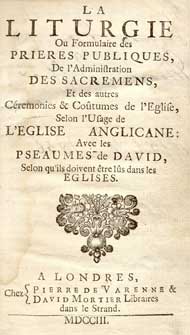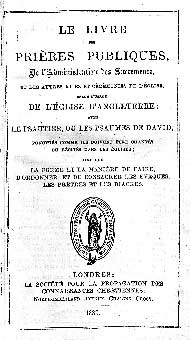PART THE SECOND
THE NON-ENGLISH LANGUAGES OF GREAT BRITAIN AND WESTERN EUROPE
CHAPTER VI
FRENCH VERSIONS FOR THE CHANNEL ISLANDS, ETC.
THE Latin and Greek translations authorized by successive Acts of Uniformity were intended primarily for scholars and university men, and such of the Irish clergy and congregations as could neither read nor speak English. These translations were of no practical value for congregational worship. To the modern scholar they are essentially witnesses to the revival of classical learning in England.
For the non-English speaking population of Great Britain and Ireland and the surrounding isles translations of the Liturgy for congregational use were soon arranged.
Of the five languages into which the Prayer Book was thus translated
the French was considered of prime importance, and a translation for
the use of the King's subjects in Calais and the Channel Islands was
made first. Soon after the first Prayer Book had been issued in 1549
a French translation was made at the command of Sir Hugh Paulet (Poulet),
military commander and governor of Jersey. Sir Hugh was born after 1500
and died about 1572. On the accession of Edward VI he was, as a known
supporter of the Protestant cause, one of those charged by the executors
of Henry VIII “with the good order of the sheres near unto them
in the West”[1].
According to Robert Watt, Bibliotheca Britannica, Vol. II (1824), p. 753 I, the first edition of the French translation was put out by Gualtier (Gaultier) in 1551, and was entitled: “Le Livre des Priers Communes, de l’Administration des Sacremens, et autres Ceremonies en l'Englishe d’Angleterre.” Francis Philip is named as the translator. Watt's statement, however, has to be accepted with great caution, inasmuch as there is, to our knowledge, no copy extant of an edition of 1551. But that there was some kind of a translation into French of the First Prayer Book is generally admitted. Strype, Cranmer (Oxford, 1840), Vol. I, pp. 416, 417, etc.; II, p. 1,035.
When the second Edwardine Prayer Book appeared, care was taken to amend the translation, already made, with regard to all the alterations, additions and omissions of this second book, so that the French version should represent as accurately as possible the English Book of Common Prayer in its amended state. Copies of this revision are now exceedingly rare. Its title reads:
* Le Livre | des Prieres Communes, De | l'administration des Sacre | mens & autres Ceremo | nies en l’Eglise | d’Angleterre. | Traduit en Francoys par Francoys | Philippe, seruiteur de Mon- | sieur le grand Chancelier | d'Angleterre. | De l’imprimerie de Thomas Gaul- | tier, Imprimeur du Roy en la lan- | gue Francoise, pour les Isles de | sa Magesté. |
Auec le priuilege general dudit | Seigneur, 1553[2]
Griffiths 36:1
[2] Thomas Gaultier, Galtier or Gualtier, was a native of France. He came to England and took out letters of denization in 1544. He printed only between 1550 and 1553, and was appointed King's printer for French service books. His printing office was in the parish of St. Martin's, Ludgate, near Fleet Bridge.
Without pagination. Page, 4 x 6⅛; paper, 5¼ x 7⅝ inches. Sig. (preliminary matter), a—e, in fours; and, again, e1, e2, (reverse blank), the second signature e undoubtedly a printer's error for f; (text) A1 — Zz 4, in fours.
Francoys Philippe, the translator, calls himself “seruiteur de Monsieur le grand Chancelier d’Angleterre.” This Lord High Chancellor was Thomas Goodrich, or Goodricke, formerly bishop of Ely. He was one of the commissioners that drew up the Bishop's Book of 1537 [3], and he assisted in the preparation of the First Book of Common Prayer[4]. He died in 1554.
The first five pages of this French translation, viz.,. sig. aij-bi, contain a dedicatory letter: “A tres reverend pere en Dieu Thomas Goodrik, Euesque d’Ely & Chancelier d’Angleterre, Francoys Philippe, treshumble salut.” “Vn Almanach pour XIX. ans” (1552-70) is printed in black and red on sig. eiii (obverse). The last page of the book, Zz iv, verso, contains the colophon, Fin du liure de prieres Communes De l’administration des Sacremens & autres Ceremonies en l’Esglise [sic] d’Angleterre.
The border of the title-page is the same as that used in the Primer of 1557, known as Queen Mary's Primer, printed in London by Abraham Vele[5].
For a short time after Mary's accession to the English throne in 1553,
the history of the Prayer Book leads us to Frankfort-on-the-Main, in
Germany. Thither Valerand Poullain (Valerandus Pollanus, Flandrus) fled
with his French and Walloon companions, driven from their new home in
England. They formed at Frankfort a considerable congregation. But soon
great trouble and dissension arose here owing to the introduction of
the Prayer Book into the public worship of the exiled congregations.
The question naturally arises, Did the translator of the Second Edwardine
Liturgy accompany Poullain to Frankfort or did he go to another city?
A recent learned monograph by Dr. Friedrich Clemens Ebrard, relating
the history of the French reformed congregation at Frankfort, 1554-1904[6],
contains positive proof of the fact that Philippe went to Frankfort and
for the period of more than a year served the congregation as their pastor,
1560-1561. When, on August 28, 1561, the Frankfort authorities closed
the churches against the foreign congregations allotted to them in 1554,
François Philippi, then pastor of the French congregation,
defended himself and his people from the pulpit; whereupon he was imprisoned
and, later on, banished from the city. The following year he published
La Defense des eglises estrangieres de Francfort
en Allemagne, par François
Philippi, ministre de l’eglise françoise de Francfort. It
is a small octavo volume of 160 pages, without place of publication or
name of publisher, and is now extremely rare[7].
[3] * The institvtion of a christen man, conteynynge the Exposytion or Interpretation of the commune Crede, of the seuen Sacramentes, of the .X. commandementes, and of the Pater noster, and the Aue Maria, Justyfication & Purgatory . . . Colophon: Londini. In aedibvs Thomae Bertheleti. . . . An. M. D. XXXVII.
The “Confession of faith” was re-issued in 1543, entitled * A necessary doctrine and ervdition for any Christen man, set furthe by the kynges maiestie of England, etc .... Colophon: Imprinted at London in Fletestrete by Thomas Barthelet .... M.D. XLIII. This edition is known as the King's Book, it having a. preface by King Henry. Of this book there were printed thirteen distinct editions, four in quarto and the others in octavo.
[4] The commissioners for the preparation of the First Edwardine Prayer Book were Thomas Cranmer, Thomas Goodrich, Henry Rands or Holbeach, George Day, John Skip, Thomas Thirl(e)by and Nicholas Ridley, from the Upper House. From the Lower House, William May, Richard Cox, John Taylor, Simon Heynes, Thomas Robertson or Robinson and John Redman or Redmayne. They were all members of the Province of Canterbury. In what manner the Convocation of the Province of York participated in the revision we know not. But there can be no doubt that its co-operation was obtained in some way.
[5] * The Primer in Englishe and Latine, set out along after the vse of Sarum: with many godlie and deuoute praiers: as it apeareth in the table.
[6] Die Französisch-reformierte Gemeinde in Frankfurt am Main, 1554-1904. Frankfurt am Main, 1906; vii, 166 (1) pp. ; portraits; plates; 4to.
[7] See, in addition, Brunet, Manuel
du libraire, Vol. IV, col. 609.
A French translation of the Hampton Court Book of King James | (1603/4) was printed in 1616. It reads:
* La | Litvrgie | Angloise | ov | le livre des | Prieres Pvbliqves, | de | l’Administration des Sacremens, & autres Ordres & | Ceremonies de l’Eglise | d’Angleterre. | Nouuellement traduit en François | par l’Ordonance de sa Maieste de | La Grande Bretaigne. | A Londres, | Par Iehan Bill, | Immprimeur du Roy. | M. DC. XVI. | Auec priuilege de sa Maieste.
Without pagination. Page, (title) 4½ x 6¼, (text) 4⅝ x 7 ; paper, 6½ x 8½ inches. The title is surrounded by a woodcut border, Fides and Humilitas on either side, the symbolic representations of the four evangelists in the four corners, and the royal crest in the centre of the top. Sigs. A — E4 in fours, for the introductory matter; last page blank; A1, reverse, containing the table of contents. Text, A — Z, Aa — Rr 3 in fours; Rr 3, reverse, blank. Follows Part II, with title in same border as the main title: Le | Livre des | Pseavmes | de David. | A Londres, | Par Iehan Bill, | Imprimeur du Roy. | M. DC. XVI. | Auec priuilege de sa Majeste. This title is printed on sig. Rr 4, obverse; reverse blank. Text, A — Z 3 in fours; Z 4 blank. Throughout the book there are many initial woodcut letters.
This translation of the Liturgy as revised by the Hampton Court Conference is a book now seldom seen and comparatively unknown. It was never, indeed, much used by the French-speaking congregations in connection with the Church of England. Unlike its predecessor of 1553 and its well-known successor of 1665 it was published anonymously. It cannot be shown definitely that the translator made use of the translation of 1553, a fact indicating that, even at so early a date, that book had become a rarity. But it is evident that the translator made use of the Latin versions of Aless and Haddon, for he incorporated also into his own translation occasionally the mistakes made by these two men.
The translator was Pierre de Laune, second son of William de Laune, minister of the reformed church of France, a physician and refugee to England in or before the year 1582. Pierre was born at Larie in 1574, and following his father’s profession as a minister of the Gospel, he was appointed pastor of the Walloon Church of Norwich in 1601. It is well known that these French Churches, as well as the Dutch, formed by refugees in England were superintended by the bishop of the diocese in which they were located, even though they all belonged to the Puritan branch of Protestantism. It is interesting to observe that occasionally, but not often, some of the ministers of the church of the Walloons at Norwich received Anglican ordination and preferment in the English Church, after giving up the charge of their Walloon congregation. Others again endeavoured to retain their standing in the Walloon Church and, at the same time, hold a cure in the Church of England. To this latter class belonged de Laune, who was pastor of the church at Norwich from 1601 to 1656. While John Jeggon (1550-1618) was bishop of Norwich (1602-1618), de Laune made his translation at the suggestion of Bishop John Williams, in order to acquaint the French at home with the character and nature of English religion and liturgy. In order to escape the stigma of proselytizing in the interest of another denomination while still pastor in a reformed Calvinistic congregation, the translator let his book be published anonymously, relying on the promise of King James to give him an English cure as a reward for his labour. This James failed to do. Twelve years later, in [June ?] 1628, de Laune petitioned King Charles I that he might be presented to the rectory of Stanford Rivers, which had been “granted him by Letters patent from his late Matie for recompense for translating the English Liturgie into French and hath noe other reward but the expectation of this, now living upon the small and uncertaine Benevolence. There being now two direcc’ons to the Clerke of the signett to present seu’all persons there vnto, hee humbly praies to stay all proceedings, that hee may be peaceably presented therevnto”[8]. The only reward, however, given the translator was the honorary degree of D.D. from Cambridge University by royal mandate, February 5, 1635/6. From the time of his petition to the king until the day of his death in October, 1657, de Laune had great trouble with his Walloon congregation, whose members objected to their pastor’s holding at the same time a cure in the Church of England.
A second edition of de Laune’s translation appeared
in 1661, shortly after the Restoration. It was used in the French
chapel at the Savoy from July 14, 1661, until a new translation had been
made. As late as 1666, John Crook printed at Dublin an edition of the
1616 translation, for use in the Church of Ireland; 140 pages, 12mo. First
three leaves not numbered; sig. A 4 is paged 7, 8; last page blank.
[8] Calendar of State Papers, Charles I, Vol. CVIII, No. 79.
Grifftihs 36:5
[9] Ibid., Charles II, Vol. XLI, p. 12.
* La | Liturgie, | C’est à dire | Le Formulaire des | Prieres Publiques, | de l’Administration | des Sacremens, | et des autres | Ceremonies & Coûtumes de l’Église | Selon l’Usage de l’Église Anglicane: | avec le | Pseautier, | ou les | Pseaumes de David, | Ponctuez selon qu’ils doivent être, ou chantez | ou leûs dans les Églises. | À Londres: lean Dunmore & Octavien Pulleyn Ie Jeune, 1665.
Griffiths 36:6
Griffiths 36:8 (1683, 1688, 1695); Griffiths 36:9 (1689)
Two editions of Durel’s translations
are known to have been issued for the use of the Church of Ireland. One
in 1704 and the other in 1715, the one printed by Andre Crook, Dublin,
the other by him pour Mr. Binauld. Pages unnumbered. Page, 2¾
x 5⅜; paper, 3½ x 6 inches. Sig. A — Z in eights, with
extra signature (a) of four leaves between A and B. The Almanack in the
edition of 1715, on folio C 1, reverse, extends from 1703 to 1740, and
has at the bottom of the page the note: Remarquez que l’Église
Anglicane commence la supputation de l’An de nôtre Seigneur
au vingt-cinquieme jour du Mars. An
edition containing French and English in parallel columns was published
in 1717 by Baskett. It reads:
[10] On Durel, see Chap. V, pp. 42-48; Vol. II of Les Églises du Refuge en Angleterre, par le baron F. de Schickler, passim, and Dowden, Further Studies in the Prayer Book, pp. 216, 217, who states that “as a matter of fact, an examination of the contents of the book shows that Dr. Stradling’s certificate was not justified. The version is inaccurate in many places.”
Irish ed.: Griffiths 36:13
* Le Livre des Prieres Communes, ... (The Book of Common Prayer, ... ) Oxford: Imprime par Jean Baskett. ... MDCCXVII.
Without pagination. Page, 31 x 7; paper, 41 x 7!- inches. Printed in double. columns. The introductory sections are wholly in English.
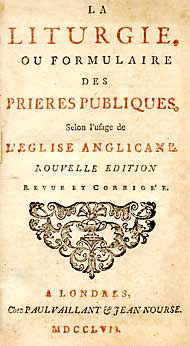
Griffiths 36:25, 1757 printing
Griffiths 36:31; 36:33 (1801); 36:38 (1806); 36:51 (1828 and many subsequent printings through 1865)
Griffiths 36:39 (1811), 36:40 (1814); 36:45 (1818); 36:48 (1823);
Mudry's translation: Griffiths 36:60 (1845, 1853, 1859); 36:69 (1863)
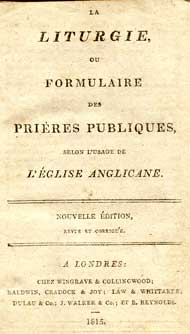
Griffiths 36:56; 36:71 (1886)
The edition differs only in minor verbal
details from the editions put out for the use of French congregations
in Mauritius and other colonies with French-speaking congregations. The
main difference is the title, which reads: Le livre des prières publiques, de l’Administration
des sacrements, et des autres rites et cérémonies de l’église,
selon l’usage de l’église d’Angleterre: avec le
Psautier, ou les Psaumes de David, ponctués comme ils doivent être
chantés ou récités dans les églises; aussi
que la forme et la manière de faire, d’ordonner, et de consacrer
les évêques, les prêtres et les diacres. [Seal of the
Society.] Londres: La société pour la propagation des connaissances chrétiennes
... 1912. x, (26), 575, (13) pages. Paper, 3¼ x 5½ inches. Pp. 1-289 in
long lines; 290-336, L’ordre du baptême — Commination,
in double columns; 336-538, Les Psaumes de David, in long lines; 539 to
the end of the volume, double columns. The Table des fêtes mobiles,
etc., on p. (21), beginning with 1889 and extending to 1908, is rather
out of date in a 1912 edition.
Griffiths 36:69
[11] The J. P. Morgan library has the 1616 edition, the copy having belonged to Charles I when Prince of Wales. It also has the 1665 edition of Durel.— The General Theological Seminary library, New York, has the editions of 1616, 1667, and 1689, and later editions.— The John Carter Brown Library has the 1553, 1616, and 1683 editions.— The Boston Public Library has an edition of 1706.— The Whittingham Library, Baltimore, Md., has editions of 1689, 1739, etc.— The Boston Athenæum has the London editions of 1705 (288, 177 pp., 12mo) and of 1739 (XXXVI, 441, 162 pp., I2mo).— The collection of the custodian of the General Convention’s standard book comprises the American editions of 1803, 1831, 1846, 1860 and 1897.— The Worcester, Mass., Antiquarian Society has a Dublin edition of 1775 (XLIX, (1), 438 pp., 16mo); also the American editions of 1831 and 1860.
[12) Journal of the Proceedings of the General Convention, 1817, P·45.
[13] Ibid., New York, 1832, pp. 37 and 84. The Rev. A. V. Wittmeyer, of New York, states in a letter. May 22, 1913: “Wanostrocht’s translation has in my eyes great merit. Still, Verren improved it considerably.”
Griffiths 36:65
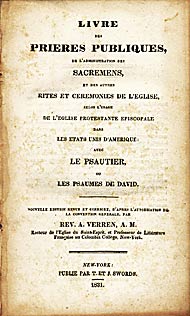
In 1844 a movement was begun to revise the translation of 1831[14]. As a result, a new edition appeared in 1846, published by the New York Bible and Prayer Book Society, xxxvi, 463, 232 pages, 18mo; printed in long lines. Part II contained the Psalms in metre. The revision was mainly the work of the Rev. Charles H. Williamson. (Journal of General Convention, 1844, pp. 21, 22, 123, 124.) This edition was reprinted in 1854, 1856, 1860 and later.
At right, the
1846 edition of the U. S. BCP in French (Griffiths 36:61)
[14] Ibid., 1844. p. 21.
Griffiths 36:61
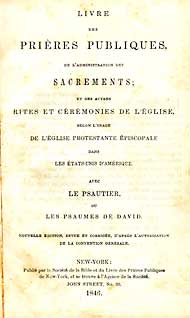
Griffiths 36:73, 36:74
[15] On this translation see ibid., 1898, p. 533, and 1904, p. 478.
[16] Letters of the translator of May 19 and 22, 1913.
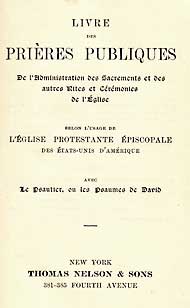
1892 BCP in French (Griffiths 36:73)
